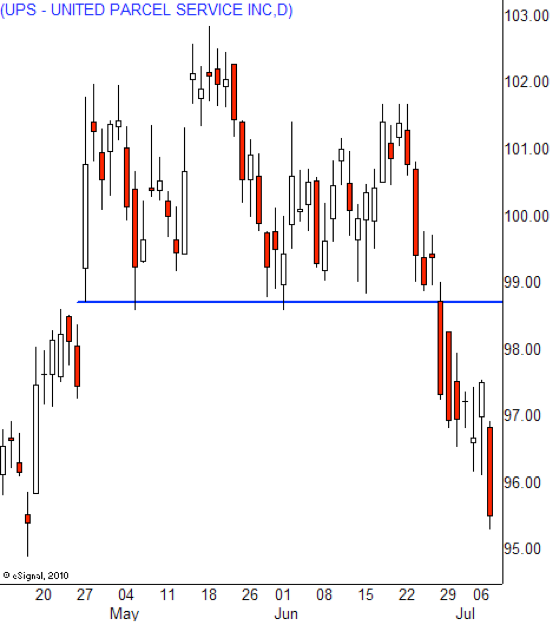
|
Remember at the beginning of this report when we said we’d show you the Three Simple Steps to Stock Profits?
We already learned about step one: picking profitable stock patterns. We’ve also covered step two: minimizing your risk. Now we’ve come to the final step that makes the system so unique: how to profit from stocks, even when the stock goes down.
It’s a common misconception that traders can only make money when the price of a stock rises.
Investors can make money anytime that they can predict a stock’s future movement – up or down.
It’s Time to Learn about Short Selling.
Short selling is the key to making cash in a down market. Here’s how it works in a nutshell
1. Identify a stock pattern that suggests a stock is headed down.

2. Borrow shares of the soon-to-decline stock from your brokerage.
- Example: Let’s say, right before the United Parcel Service pattern (above) breaks out and moves downwards, you borrow 200 shares of the stock.
3. Immediately sell these borrowed shares.
- Example: You immediately sell these borrowed shares of United Parcel Service at the price just below the support line: $98.50 per share, 200 shares = $19,700. You are now sitting on $19,700. But, of course, you still owe the brokerage 200 shares, which you don’t currently have anymore.
4. Wait for the stock to drop to your target price.
- Example: You wait for the stock to reach the target price, which in this example is $95.50 per share.
5. Buy the shares at the target price.
- Example: You use the $19,700 you made earlier to purchase 200 shares at $95.50 per share. That costs you $19,100 and leaves you with an extra $600 in your account.
6. You return the shares to your brokerage.
- Example: Return the 200 shares of United Parcel Service to your brokerage.
7. Enjoy your profits.
- Example: You earned $600, a 3% profit on $19,700. And even better, you made $600 when the price of UPS declined and many investors were losing money on the same stock!
If you want to learn more about short selling in detail, check out our Short Selling Guide.
Conclusion - Top 5 Reasons to Try Chart Advisor
-
 Financial Advisor
Financial AdvisorWhy You Should Never Short a Stock
Short selling a stock means you are betting on the stock decreasing in price. Before taking on this investment, you should fully understand the risks. -
 Investing
InvestingTips for Managing Your Portfolio Before Turning 30
Young investors have some advantages over their older counterparts. Learn how to build a portfolio to grow both your financial education and bank account. -
 IPF - Broker
IPF - BrokerThe Complete Guide to Choosing an Online Stock Broker
Online stock brokers have made high-risk, high-reward investing available to the broader public. -
 Investing
InvestingWhat First Time Investors Can Expect
These tips will help shed light on what first-time investors can expect. -
 Trading
Trading6 Steps To A Rule-Based Forex Trading System
Learn to add structure to your trading methods with these six important steps. -
 Investing
InvestingWomen: Invest In Your Financial Literacy
Learning about money may seem intimidating, but it's not as hard as it looks. -
 Investing
InvestingIs Your Money Safer in the Market or Held as Cash?
When stock markets become volatile, investors get nervous. Learn if you should take your money out of the stock market or if its safer kept in the market.


